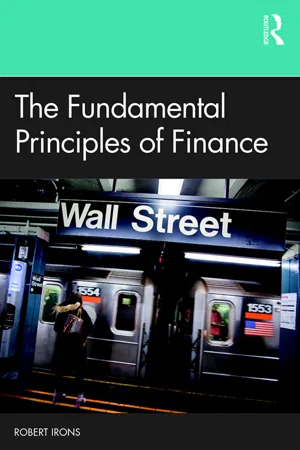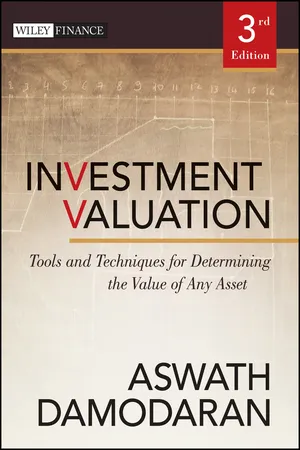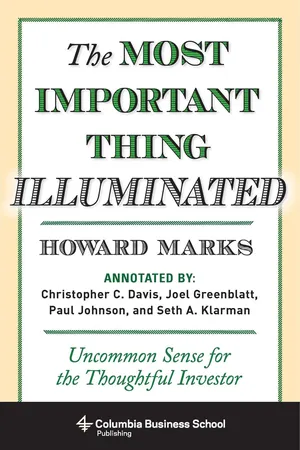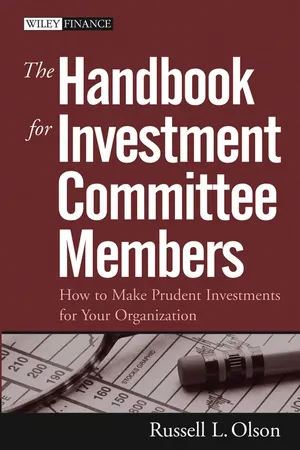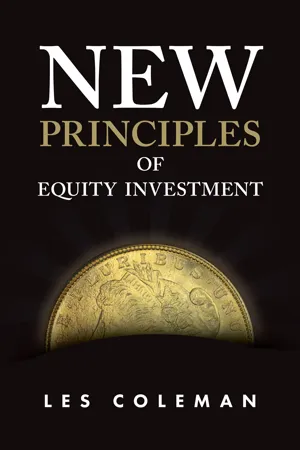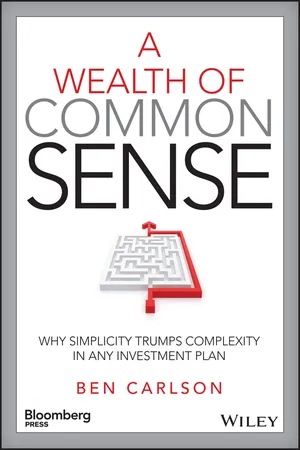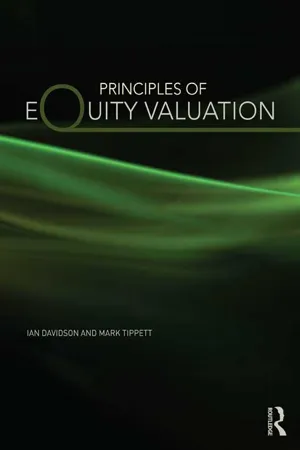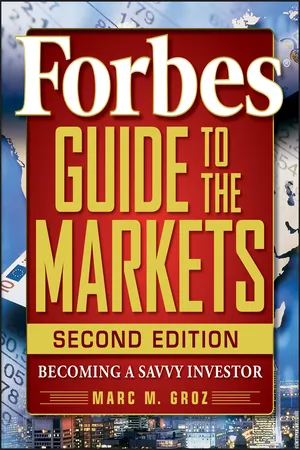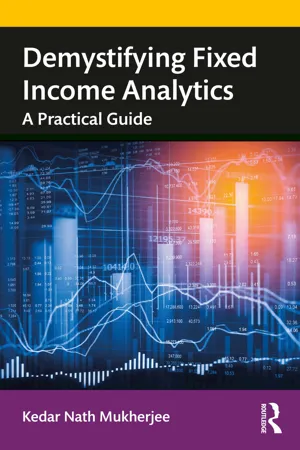Economics
Risk and Return
Risk and return are fundamental concepts in investment and finance. Risk refers to the uncertainty or potential for loss associated with an investment, while return is the gain or profit earned from that investment. Generally, higher returns are expected to come with higher levels of risk, and investors must carefully consider and balance these factors when making investment decisions.
Written by Perlego with AI-assistance
Related key terms
10 Key excerpts on "Risk and Return"
- eBook - ePub
- Robert Irons(Author)
- 2019(Publication Date)
- Routledge(Publisher)
3 Risk and ReturnBusinesses constantly face risks, some recurring (like the risk of a competitor designing a newer, better product), others new and different (like the risk of an economic recession) and all seemingly never-ending. Risks come in many different forms and different levels of severity. Part of being a good manager is being able to understand the nature of the risks the firm faces and determine the return necessary to make the risks worth bearing.The last sentence above implies a relationship between Risk and Return, and that relationship is important for you to understand. That relationship is stated clearly in our second fundamental principle (FP2), which identifies the positive nature of the relationship between Risk and Return. This relationship is so important that it is usually a mistake to discuss an investment’s return without also discussing its risk. In this chapter, we will discuss the different types of risk firms (and investors) face, how these risks are measured and how they compare to returns. We will also discuss how to calculate returns over a holding period, as well as how to calculate mean annual returns over an extended period of time.The Fundamental Principles in Action
FP2 states that there is a direct (or positive) relationship between perceived risk and required return. This principle is clearly seen when calculating expected returns using the Security Market Line. PR3 examines the inverse relationship between value and the risk, while PR1 describes the inverse relationship between value and the discount rate. These two precepts are linked by the direct relationship between Risk and Return, since the return to shareholders is used as the discount rate for valuing the firm’s common shares. - eBook - ePub
Investment Valuation
Tools and Techniques for Determining the Value of Any Asset
- Aswath Damodaran(Author)
- 2012(Publication Date)
- Wiley(Publisher)
The final part of this chapter considers default risk and how it is measured by ratings agencies. By the end of the chapter, we should have a way of estimating the equity risk and default risk for any firm.WHAT IS RISK?Risk, for most of us, refers to the likelihood that in life’s games of chance we will receive an outcome that we will not like. For instance, the risk of driving a car too fast is getting a speeding ticket or, worse still, getting into an accident. Merriam-Webster’s Collegiate Dictionary , in fact, defines the verb to risk as “to expose to hazard or danger.” Thus risk is perceived almost entirely in negative terms.In finance, our definition of risk is both different and broader. Risk, as we see it, refers to the likelihood that we will receive a return on an investment that is different from the return we expect to make. Thus, risk includes not only the bad outcomes (returns that are lower than expected), but also good outcomes (returns that are higher than expected). In fact, we can refer to the former as downside risk and the latter as upside risk, but we consider both when measuring risk. In fact, the spirit of our definition of risk in finance is captured best by the Chinese symbols for risk:Loosely defined, the first symbol is the symbol for “danger,” while the second is the symbol for “opportunity,” making risk a mix of danger and opportunity. It illustrates very clearly the trade-off that every investor and business has to make—between the higher rewards that come with the opportunity and the higher risk that has to be borne as a consequence of the danger.Much of this chapter can be viewed as an attempt to come up with a model that best measures the danger in any investment, and then attempts to convert this into the opportunity that we would need to compensate for the danger. In finance terms, we term the danger to be “risk” and the opportunity to be “expected return.”What makes the measurement of risk and expected return so challenging is that it can vary depending on whose perspective we adopt. When analyzing the risk of a firm, for instance, we can measure it from the viewpoint of the firm’s managers. Alternatively, we can argue that the firm’s equity is owned by its stockholders, and that it is their perspective on risk that should matter. A firm’s stockholders, many of whom hold the stock as one investment in a larger portfolio, might perceive the risk in the firm very differently from the firm’s managers, who might have the bulk of their capital, human and financial, invested in the firm. - eBook - ePub
The Most Important Thing Illuminated
Uncommon Sense for the Thoughtful Investor
- Howard Marks(Author)
- 2013(Publication Date)
- Columbia University Press(Publisher)
Because of their dislike for risk, investors have to be bribed with higher prospective returns to take incremental risks. Put simply, if both a U.S. Treasury note and small company stock appeared likely to return 7 percent per year, everyone would rush to buy the former (driving up its price and reducing its prospective return) and dump the latter (driving down its price and thus increasing its return). This process of adjusting relative prices, which economists call equilibration, is supposed to render prospective returns proportional to risk. So, going beyond determining whether he or she can bear the absolute amount of risk that is attendant, the investor’s second job is to determine whether the return on a given investment justifies taking the risk. Clearly, return tells just half of the story, and risk assessment is required. Third, when you consider investment results, the return means only so much by itself; the risk taken has to be assessed as well. Was the return achieved in safe instruments or risky ones? In fixed income securities or stocks? In large, established companies or smaller, shakier ones? In liquid stocks and bonds or illiquid private placements? With help from leverage or without it? In a concentrated portfolio or a diversified one? Surely investors who get their statements and find that their accounts made 10 percent for the year don’t know whether their money managers did a good job or a bad one. In order to reach a conclusion, they have to have some idea about how much risk their managers took. In other words, they have to have a feeling for “risk-adjusted return.” JOEL GREENBLATT: However, many individual and institutional investor decisions are based on this number, which has little explanatory or predictive value. Figure 5.1 It is from the relationship between Risk and Return that arises the graphic representation that has become ubiquitous in the investment world (figure 5.1) - eBook - ePub
The Handbook for Investment Committee Members
How to Make Prudent Investments for Your Organization
- Russell L. Olson(Author)
- 2011(Publication Date)
- Wiley(Publisher)
Over a 10-year interval, Fund A earned 12% per year while Fund B earned only 10% per year. Both funds had negative returns in some years, but in their negative years Fund A was down 5 percentage points more than Fund B. Which was the better fund?The answer may depend on our willingness to take on risk. Risk is the flip side of investment return. The higher the expected return, the higher the expected risk. That’s a truism—and pretty true (although not always). It doesn’t necessarily work the other way, however. The higher the risk does not necessarily mean the higher the return. Casinos, for example, can be high risk, but for the gambler they all have a negative expected return.What is risk?Most fundamentally, risk is the probability of losing money—or that the value of our investment will go down. Most investments other than U.S. Treasury bills and insured bank accounts have some reasonable probability of losing money. Other risks are outlined on the following page.VolatilityThe most widely used definition of risk is volatility—how much market values go up and down over time. Volatility is most widely used because it is the most measurable of all risks. Also, over long intervals of time, the volatility of a portfolio encompasses most of the above risks. Volatility measures the uncertainty surrounding an investment, or a portfolio of investments. Because it is measurable, it is more controllable.How do we measure volatility? The simplest measure is annual standard deviation from the asset’s (or portfolio’s) mean rate of return, the same standard deviation measure we may have learned to calculate in high school or college algebra. A low standard deviation of investment returns over time means we had pretty high certainty of investment results. A high standard deviation means we had a high degree of uncertainty. Low volatility is good, high is bad.EXAMPLES OF SPECIFIC RISKS- Loss of Buying Power.
- eBook - ePub
- Les Coleman(Author)
- 2019(Publication Date)
- Emerald Publishing Limited(Publisher)
Looking ahead, we will combine the dictionary definition of risk with Knightian uncertainty. Thus the risk of equity investment is a downside measure equal to the hard-to-estimate possibility of return below the investor’s opportunity cost or benchmark. It comes from two sources. One is knowledge risk, or the possibility that new information will emerge to alter the investment decision (see Coleman & Casselman, 2016). The other is uncertainty in outcome, given that return from equity investment is the manifestation of numerous time-varying and non-quantifiable variables.The Relationship between Return and Risk
A central tenet of contemporary finance is the existence of a positive, linear relationship between return and risk. According to Modigliani and Modigliani (1997, p. 45), for instance: ’it is well known that investors can increase expected returns simply by accepting a greater level of risk’. In their introduction to a study on the topic, Ghysels, Santa-Clara, and Valkanov (2005) concurred: ’this risk–return tradeoff is so fundamental in financial economics that it could well be described as the "first fundamental law of finance"’.Unfortunately the positive return–risk nexus is an influential misconception that does not stand up to scrutiny. Ex post studies variously report that the relationship is significantly positive, significantly negative and insignificant (see a summary of disparate results in Scruggs, 1998). When Risk and Return are considered ex ante as their expected values, neither can be directly observed nor even has a reasonable proxy, so any link between them cannot be tested. There are practical reasons to doubt a positive return–risk relationship because it is unable to accommodate securities that have a negative expected return such as firms in bankruptcy; and a linear return–risk trade-off has the challenging corollary that each investment with a given return must have the same risk.In fact, evidence is clear that the return–risk relationship is probably negative rather than positive. For instance, Fama and French (1992) identified a negative relationship between Risk and Return at the equity market level. An analogous finding comes from observation that idiosyncratic risk has an inverse relationship with price-to-book ratio (Amit & Wernerfelt, 1990): a high price-to-book ratio indicates superior management and better investment prospects (Zhang, 2005), which is associated with lower risk. A negative relationship is also found at the firm level where the Bowman (1980) Paradox arose from finding that more profitable companies have lower risk as measured by variability in profits. This inverse return–risk relationship has been widely confirmed in subsequent studies which find consistent evidence that safe, incident-free operations are the most profitable. Typical examples are given by US nuclear power plants where higher reliability is associated with higher earnings by plant operators (Osborn & Jackson, 1988); and also by airline bond ratings which are related to operational safety (Noronha & Singal, 2004) and indicate that low-risk operations accompany low risk of default. Further confirmation came out of my own study of large US firms that are fined for environmental breaches, unsafe workplaces or fraudulent accounting standards and announce product recalls (Coleman, 2010): these indications of inherent operating risk and uncertainty were followed by significant declines in sales margin and shareholder return. - eBook - ePub
A Wealth of Common Sense
Why Simplicity Trumps Complexity in Any Investment Plan
- Ben Carlson(Author)
- 2015(Publication Date)
- Bloomberg Press(Publisher)
Aside from experience in dealing with the markets on a regular basis, something that only comes with time, there's probably not much that we can do to dampen these types of emotions except acknowledge that they exist. It's always going to feel more comfortable taking risk when there is a perceived amount of certainty (read: gains) than when there is a perceived amount of uncertainty (read: losses). Knowing that we think this way is useful when creating an investment plan because you can find ways to systematically root out the bad behavior. Acceptance is the first step.Risk versus Uncertainty
War is the realm of uncertainty; three quarters of the factors on which action in war is based are wrapped in a fog of greater or lesser uncertainty.—Carl von ClausewitzThe list of uncertainties in the markets is seemingly endless—interest rates, corporate earnings growth, the rate of inflation, future tax rates, economic growth, political posturing, consumer confidence—the list could go on forever. As author James Playsted Wood said, “The thing that most affects the market is everything.” The list of distractions investors are forced to deal with is also a mile long—the hottest markets, the best performing stocks, continuous economic data releases, new fund rollouts, pundit predictions, your brother-in-law bragging about his penny stocks, and so on.Charles Ellis once said, “Forecasting the future of any variable is difficult, forecasting the interacting futures of many changing variables is more difficult, and estimating how other expert investors will interpret such complex changes is extraordinarily difficult.”5 It can make your head hurt just thinking about it, but it's true. No one is ever going to completely understand the exact forces that drive the markets for the simple fact that no one can predict the future. A willingness to admit what it is that you don't know frees you up from the illusion of certainty in your prediction skills.Risk is defined as the exposure to the chance of injury or loss. At times it can feel like you become injured when you lose money, so this is an apt definition. Uncertainty, on the other hand, is an unforeseeable event or outcome. It's easy for investors to confuse risk and uncertainty, but you have to be aware of the fact that things are always uncertain. They just feel more certain when markets are rising and more uncertain when they're falling. - eBook - ePub
- Ian Davidson, Mark Tippett(Authors)
- 2012(Publication Date)
- Routledge(Publisher)
2 The relationship between return and risk§2-1. In Chapter 1 , we identified some of the pitfalls that can arise from the incorrect calculation and averaging of the returns that accrue on shares, bonds, portfolios and other financial instruments. Historical returns are often used to provide guidance about the likely magnitude of future returns on a given security or financial instrument and of the current prices that ought to be paid for them. Moreover, historical returns are also used to assess the risks that are likely to arise from particular investments. Our purpose in this chapter is to summarize the relationships that exist between the returns that arise on particular investments and the risks that must be taken to achieve them. We also determine what implications these relationships will have for the pricing of risky assets. We begin our analysis in the next section with a consideration of how the risks associated with investments shape the returns that we can expect from them. We then go on to demonstrate how assets are priced so as to be compatible with the risks and returns that arise from them.§2-2. Consider a portfolio comprising j = 1,2,3,4, …, N risky assets. The expected return on the portfolio, E(Rp ), will bewhere E(Rj ) is the expected return on the jth asset and wj is the proportion of the investor’s wealth that is invested in the jth asset. Sometimes, we will use the symbol μ = E(Rp ) to represent the expected return on the portfolio; the two symbols will be used interchangeably. Thus, the expected return on an N = 2 or two-asset portfolio will be computed from the following formula:We can illustrate the application of this formula by supposing that the expected return on the first asset is E(R1 ) = 0.2 or 20 per cent (per annum) and the expected return on the second asset is E(R2 - eBook - ePub
Forbes Guide to the Markets
Becoming a Savvy Investor
- Marc M. Groz(Author)
- 2009(Publication Date)
- Wiley(Publisher)
Calculation of raw investment performance tells you how much an investment made or lost, but does not provide a context for evaluating that investment in the light of your unique risk profile. Such an evaluation requires an understanding of how risk relates to performance, the subject of our next chapter.Passage contains an image
Chapter 20COMING TO GRIPS WITH THE MANY DIMENSIONS OF RISKWe begin with a definition of investment risk, illustrated with an example. Then we explain the key concept of market risk and some of the ways it is measured. Next, we offer an overview of some of the other kinds of risks faced by investors, ranging from those that can be quantified to those that are more subjective. Finally, we present a perspective on risk that strives to balance complementary risks against each other.A Definition of Investment Risk
If there are many ways to measure an investment’s rate of return, there are even more measures of investment risk. The complexity embodied in the idea of risk means that it cannot be adequately captured by any single measurement or number. Nevertheless, there is an underlying unity that links the different kinds of investment risk:Risk is the chance that your investment goals will not be realized in the time frame you specify.Notice that the definition says goals, and not merely results. Unfortunately, investors are not always clear on what their goals are. Furthermore, an investor’s goals can, and frequently do, change in response to the following:• Changes in the investor’s financial situation • Changes in the investment climate • Changes in the economyThe Relativity of Risk
Recognition that risk is relative to an investor’s goals, time horizon, and other constraints helps avoid confusion in thinking about risk. An example further illustrates the point. Let’s say you are deciding how to invest $100,000. You have the following three goals:A1 To at least double your money in the next six years A2 To keep up with a broad market index, like the S&P 500, never falling below its rate of return as measured quarterly A3 To never be down more than 10 percent in any given calendar year - eBook - ePub
- Tony Merna, Faisal F. Al-Thani(Authors)
- 2011(Publication Date)
- Wiley(Publisher)
Once the probability, cause and effect of an occurrence can be determined then a probability distribution can be computed. From this probability distribution, over a range of possibilities, the chances of risk occurring can be determined, thus reducing the uncertainty associated with this event.The authors suggest that uncertainty can often be interpreted as prophecy, since a prophecy is not based on data or experience. A prediction, however, is normally based on data or past experience and thus offers a basis for potential risk.2.3 RISK AND UNCERTAINTY: BASIC CONCEPTS AND GENERAL PRINCIPLES
According to Chapman and Ward (1997):Risk and uncertainty are distinguished by both Bussey (1978) and Merrett and Sykes (1983) as:All projects involve risk – the zero risk project is not worth pursuing. Organisations which better understand the nature of these risks and can manage them more effectively can not only avoid unforeseen disasters but can work with tighter margins and less contingency, freeing resources for other endeavours, and seizing opportunities for advantageous investment which might otherwise be rejected as too risky.A decision is said to be subject to risk when there is a range of possible outcomes and when known probabilities can be attached to the outcome .Uncertainty exists when there is more than one possible outcome to a course of action but the probability of each outcome is not known .In today’s business, nearly all decisions are taken purely on a financial consequences basis. Business leaders need to understand and know whether the returns on a project justify taking risks, and the extent of these consequences (losses) if the risks do materialise. Investors, on the other hand, need some indication of whether the returns on an investment meet their minimum returns if the investment is fully exposed to the risks identified. (Merna 2002) suggests: - eBook - ePub
Demystifying Fixed Income Analytics
A Practical Guide
- Kedar Nath Mukherjee(Author)
- 2020(Publication Date)
- Routledge India(Publisher)
Bonds are an important component of investment portfolios for most investors, especially for institutional investors. Bonds reduce the overall risk of a portfolio by introducing diversity. Bonds produce steady current income – income that investors receive, say in every year/six months/quarter. This steady stream of income is important to some investors, depending on their asset-liability structure and their current needs. Bonds are more low-risk investments than stocks, sometimes at the cost of lower returns. The attractiveness of bond investment largely depends upon the future movement of interest rates. Bonds are attractive options when the market anticipates interest rates to fall. As interest rates fall, bond values rise, giving a positive return to the investor. The main sources of return from a bond are: regular (annual/semi-annual) coupon income, reinvestment income (i.e. interest on coupon received), and bond’s price appreciation (if any). Even if the coupon rate, the major source of return from a bond, is fixed in a fixed rate bond, there may be several risk factors causing different levels of variation in the returns from a bond. Alternatively, bonds are susceptible to a number of risks, depending on the nature of the bond issue. Like other investment opportunities in the financial market, the risk-return linkage is also applicable in a bond investment. If an investor wants to earn a higher return, he has to compromise with some risk factor(s), such as credit risk, interest rate risk, liquidity risk, etc. There can be different measures available to capture the Risk and Return from an individual security, or a portfolio of many securities. These are discussed in the following section.Risks associated with fixed income securitiesInvestment in any financial asset generates a return subject to some uncertainty. This uncertainty may be favourable or unfavourable to an investor. Any uncertainty that causes any kind of financial losses for the investor is generally termed as ‘Financial Risk’. In other words, risk refers to the Chance of Financial Losses due to unforeseen or random changes in underlying Risk Factors. Since the goal of investing is to get the best return possible from the investment, investment risk is the possibility that the investor will get back less than their investment or their expected return, or that they will get less than what they could have had if they had invested their money elsewhere, commonly known as Opportunity Costs
Index pages curate the most relevant extracts from our library of academic textbooks. They’ve been created using an in-house natural language model (NLM), each adding context and meaning to key research topics.
